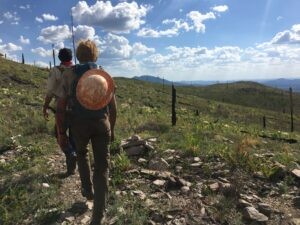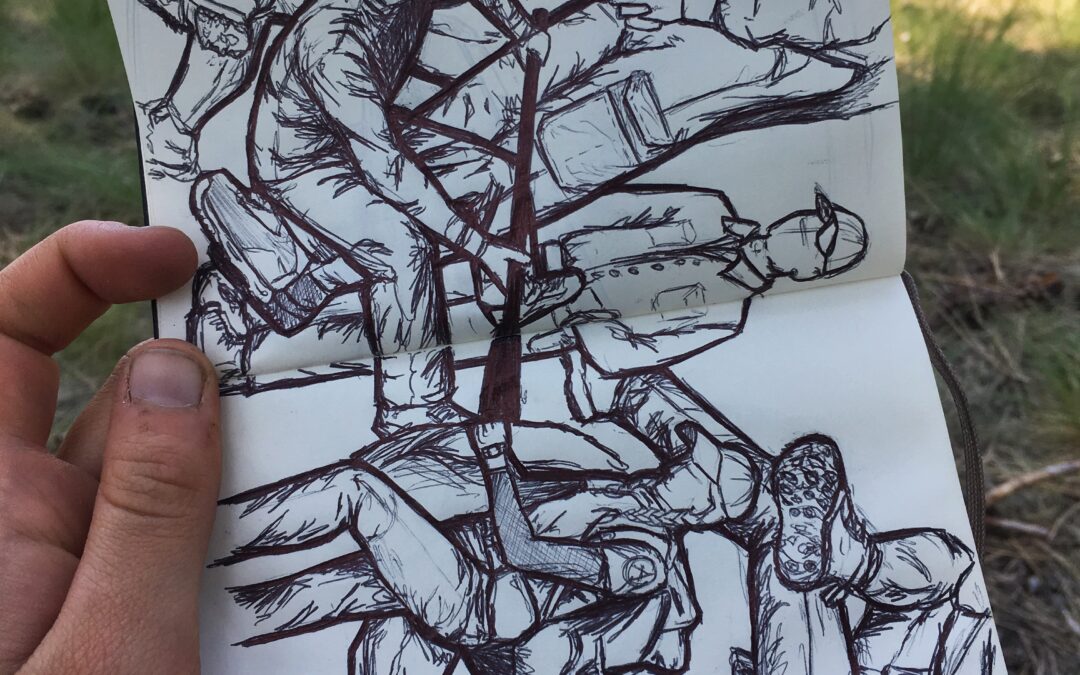Have you ever looked back on a time and realized how pivotal that moment was? I reflect on the day I applied for ACE, and the ripples of that decision continue even now. At the end of the summer of 2019, I found myself blubbering to my new closest friends about how sad I was to leave, feeling both sure and unsure of my next steps.
I was in my second year of studying graphic design and was starting to question my career trajectory. I enjoyed design but feared that it was signing myself up to be behind a computer for the foreseeable future. I was looking for an experience that would give me clarity on how to be creative in conservation.
I expressed these feelings to a friend who had just gotten back from a term with ACE out in Utah. He encouraged me to apply and in two weeks, I was flying out to Arizona. I arrived at housing in Flagstaff around midnight, after a long journey involving a plane, bus, and a final leg in an Uber. I walked into the common room after 20 hours of travel and looked around at the strangers sitting on the couches. I remember feeling intimidated for the first few days but as the days unfolded, and my surroundings became more familiar, a camaraderie began to emerge.
On the first project, 8 of us and our belongings crammed into a van and headed to Prescott National Forest. A routine developed pretty quickly, which consisted of prying myself out of my sleeping bag, donning the same shirt worn for the past six workdays, and stumbling toward our makeshift cooking station. Breakfast often took a backseat to precious sleep, and hastily scarfing down granola became the ritual before tossing our lunches into day bags and heading to the project site. Once there, morning stretches accompanied by the Question of the Day (Q-of-the-D) set a light-hearted tone, aiming to just make each other laugh and wake up our brains for the day to come.
Now our lunches… a culinary journey that evolved into a bizarre concoction as the hitches progressed. My self-made lunches took on a grotesque charm, culminating in a gourmet sandwich featuring a quesadilla wrap, leftover rice, fruit gummies, and mustard. Unconventional, perhaps, but it became a strangely satisfying fuel for the demanding work ahead.
The projects during the day consisted of pushing boulders, building trails, removing fences, and combating invasive species. As the sun dipped below the horizon, exhaustion mingled with satisfaction. The lengthening trail, the transformed landscape, and the shared sense of accomplishment culminated in a job well done. We’d end the day exhausted, yet satisfied.

Crew members in Kaibab National Forest
Post-ACE, I flew home from Flagstaff with a sense of empowerment, but I also felt confused. The incredible outdoor experiences ignited a desire to make the natural world my career. In pursuit of this passion, I made a swift (and short-lived) academic detour, switching my major to forestry. I quickly realized that though I wanted to work in the outdoors, my enthusiasm did not transform me into a chemistry whizz. With my head hung low, I switched back to graphic design and slumped my way over to the career office.
Questions swirled in my mind. How could conservation intertwine with the world of creatives? Can marketing and sustainability coexist, or are they fundamentally at odds? It was within this fog of uncertainty that a golden nugget of advice emerged—one that took time to sink in. ‘Conservation can be marketed,’ someone remarked, illuminating a new path. They urged me to tailor my designs towards companies and projects supporting the outdoors, suggesting that creativity could be a powerful ally in championing environmental causes.
Now how to practice this? Turns out, if you offer free work, most places will take you on. I started searching for local organizations that my values aligned with, then reached out to see if they needed design work. I’d do background research on organizations in my area, and approach them about how I could contribute to their marketing or design portfolio. This isn’t feasible for everyone, and I would not recommend it for most, but it’s how I got my foot in the door and gained experience working for nonprofits.
I began actively seeking out mission-oriented organizations and delving into their current materials to identify areas that could benefit from a creative facelift. Taking it upon myself to revamp those designs, it became clear that the goal was more than just aesthetic improvement; it was about weaving a powerful narrative through visuals that would resonate with people. This experience drove home the point that when it comes to advocating for the environment, creativity isn’t just a nice-to-have – it’s the language that breaks down barriers, grabs hearts, and motivates people to take action. Whether it’s through eye-catching designs, compelling stories, or out-of-the-box campaigns, creativity is the driving force that turns environmental advocacy into a powerful call for everyone to step up and take responsibility.
As I look back on that pivotal summer in Flagstaff, I am grateful for the confusion it brought. Three months may seem fleeting, but my time in place planted the seeds for a career supporting outdoor conservation. ACE became more than a program; it became a place to gain skills, explore career opportunities, and build lifelong friendships. It taught me the value of working for a cause greater than myself, of finishing a day dusty and exhausted, yet satisfied.
For those contemplating a similar path, consider mission-oriented work as a gateway to gaining skills with organizations whose values align with yours. It’s not just about a job; it’s about immersing yourself in the field, contributing to a cause you believe in, and letting your creativity be a force for positive change. ACE is not just a place for a summer; it’s a transformative experience that equips you to navigate the intersection of creativity, conservation, and meaningful impact.
